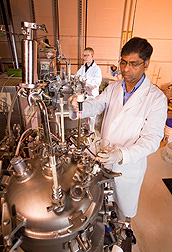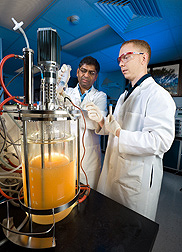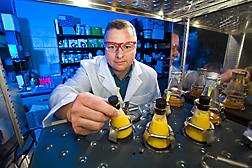Niches and Glitches in Ethanol Production
All plant matter, from small piles of grass clippings on the lawn to overgrown masses of kudzu enveloping entire hillsides, contains sugars that could be fermented to make cellulosic ethanol. That’s why Agricultural Research Service scientists at the National Center for Agricultural Utilization Research (NCAUR) in Peoria, Illinois, are working to optimize cellulosic ethanol production and yield from the field to the fuel pump.
Since commercial cellulosic ethanol production will probably be fueled by a diverse collection of plant feedstocks, it won’t be a one-size-fits-all process. Bringing commercial production online will depend on finding feedstocks that have suitable carbohydrate levels, finding cost-effective ways to free the sugars stored in those carbohydrates, and finding microorganisms that ferment all sugars.
ARS chemist Badal Saha has just wrapped up a 5-year study and concluded that wheat straw—a crop residue left over after the grain has been harvested—could have commercial potential for cellulosic ethanol production. Saha works in NCAUR’s Bioenergy Research Unit.
A key step in cellulose conversion is finding effective ways to pretreat different feedstocks and break down the cell walls, where most of the sugar is stored. There is a long list of pretreatment options that use a range of chemical and physical processes, and each one has its drawbacks and benefits.
Saha found that he could access and ferment almost all the sugars in wheat straw when he pretreated it with alkaline peroxide and then used enzymes to break down the cellulose into sugars for fermentation, a process called “enzymatic saccharification.” The ethanol yield was about 93 gallons per ton of wheat straw. A plus: This approach did not produce substances called “fermentation inhibitors,” which sometimes develop as a result of pretreatment dynamics and reduce ethanol yield.
Pretreating wheat straw with lime also resulted in a good ethanol yield—around 83 gallons per ton of straw. As with the alkaline peroxide pretreatment, lime pretreatment didn’t prompt the development of fermentation inhibitors, and it produced sugars that were easily fermented. It is also a much cheaper alternative to alkaline peroxide pretreatment.
Saha was also pleased that he obtained good ethanol yields when he combined barley straw with wheat straw. Rice hulls also showed promise as a biofuel feedstock, even though their high silica content lessened the final ethanol yield to only around 59 gallons per ton of feedstock.
Although cellulosic ethanol conversion processes often use yeast for fermentation, conventional yeast is not capable of fermenting all the sugars released from cellulosic feedstocks. So Saha worked with bacteria instead, and used a strain of E. coli bacterium that had been genetically enhanced to bolster its fermentation abilities. He wanted to see if this strain could sustain good fermentation rates at industrial production levels.
“We tested the E. coli continuously for 4 months to ferment wheat straw,” Saha says. “When we looked at the results, we didn’t see any loss of bacterial productivity. The ethanol yield remained consistent throughout the study, which is a good sign that the E. coli can maintain good fermentation rates in prolonged production cycles.”
Saha is ready to move to the next stage. “In four trials, we successfully demonstrated the conversion of wheat straw into ethanol at a 10-liter scale,” he says. “Now we want to scale up to 100 liters and conduct a cost analysis of the production process.”
|
|
The Sick Ward
An ethanol plant is not a pristine place. The brew of liquids, chemicals, and plant matter used to produce ethanol also gives rise to organisms that can infect the system and disrupt production until the bad guys—which are usually bacterial species that produce lactic acid—are under control.
These bacteria can grow rapidly and thrive in environments with low pH levels and relatively high alcohol levels, conditions that are both commonly found in ethanol production. The organisms fuel their growth with the plant sugars that would otherwise be fermented into alcohol. And when the bacteria usurp the sugars for their own growth, they produce lactic and acetic acids, which harm the fermenting yeast.
The result: a “stuck” fermentation. Sometimes antibiotics can take care of it, but other times, infected facilities need to be completely shut down for a thorough cleanup.
Microbiologist Ken Bischoff and geneticist Tim Leathers, who work in NCAUR’s Renewable Product Technology Research Unit, have now become unofficial ethanol epidemiologists as well. “Chronic infections can reduce ethanol yields 2 to 4 percent, which is a lot at a plant that produces 100 million gallons of ethanol a year,” Bischoff notes.
Leathers decided to do an identity check of the microbes that were derailing ethanol production. He collected bacteria samples from a wet-mill commercial grain-ethanol facility that had never been treated with antibiotics and from a dry-grind facility that had been dosed with antibiotics after bacterial outbreaks and was not actively infected at the time of the study. He found that most of the bacterial isolates he collected from both facilities were different types of lactic acid bacteria.
After investigating the antibiotic susceptibility of these samples, Bischoff developed a shake-flask model for simulating bacterial contamination and infection. He found that when test cultures were inoculated with Lactobacillus fermentum—one of the most common sources of bacterial infections in ethanol plants—ethanol yield decreased by 27 percent. The infections could sometimes be cured by treating them with virginiamycin, an antibiotic commonly used in the ethanol industry. But one strain of L. fermentum was already resistant to treatment.
Bischoff hopes his model can help the ethanol industry develop alternative methods to control bacterial outbreaks and improve the production process.
“Bacterial contamination is a unique niche in ethanol research,” Bischoff says. “It’s new, and it’s an area where ARS can support the industry and really make a difference.”
The research in this story supports the USDA priority of developing new sources of bioenergy.—By Ann Perry, Agricultural Research Service Information Staff.
This research is part of Bioenergy and Energy Alternatives (#307) and Quality and Utilization of Agricultural Products (#306), two ARS national programs described at www.nps.ars.usda.gov.
To reach scientists mentioned in this story, contact Ann Perry, USDA-ARS Information Staff, 5601 Sunnyside Ave., Beltsville, MD 20705-5129; (301) 504-1628.
"Niches and Glitches in Ethanol Production" was published in the April 2010 issue of Agricultural Research magazine.









